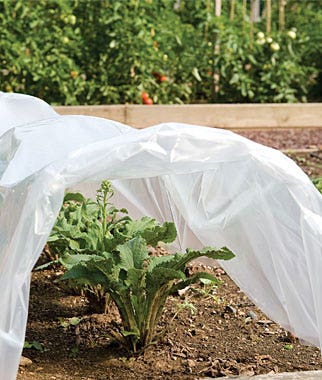We use cookies to give you the best experience on our website. These cookies are completely safe and secure and will never contain any sensitive information. Please read our Privacy Policy. By clicking "Ok" or clicking on any other content, you agree that cookies can be placed.
Floating Row Covers
Plants in our gardens are on their own in a lot of ways. We feed and water them.
But we don’t offer them much in the way of protection from the elements and pests.
It’s possible to create a more perfect world for our plants, specifically vegetable plants, by
using floating row covers.
“It gives them a fighting chance,” said David Heidebrink, owner and operator of Heide-Way Farm
in Wakefield, Kansas. Heide-Way is a CSA that utilizes floating row covers to help
them produce the best produce for their customers. Row covers also allow the Zone 5 farm
to offer winter shares of leaf and root vegetables.
Floating row covers are made of very shear, lightweight fabric that can be simply draped over
your vegetables. They are easy to use in home gardens.
The advantages of tucking veggie plants under a thin sheet are many.
“The most important benefit to home gardeners is the extension of the growing season,” said
Heibebrink, “ This is especially important in northern climates.”
Row covers trap heat close to plants and keeps wind from blowing the heat away as the
temperature cools. Growing seasons, depending on the zone, can be extended by weeks in both
spring and autumn. Plants are warmer under cover and soil is more evenly moist.
Wind dries the ground and beats up the plants, he said. Covers create a
microclimate and a more perfect environment for vegetables.
“Row covers protect crops from wind damage, drought, insects, pests and cold,” said Heidebrink.
They also protect crops from light hail damage.
Insect pressure is reduced with floating row covers in a couple of ways. The added warmth
from covers allows vegetables to be started early. Plants get a growth jump-start ahead
of insects, giving plants a gift of maturity before bugs get really bad.
Covering also acts as a physical barrier. For example, when growing crops like
greens and cabbages, row covers prevent moths from laying eggs on the young plants. The eggs
become larvae - cabbage worms- and feed on plants weakening them.
The barrier effect works with larger pests as well, said Heibebrink. The cover
deters rabbits and deer from eating your crops.
To use the covers, loosely drape them over your crops and secure the edges. Heidebrink
said the best way to hold the covers in place is to place heavy objects along the edge of the
covering. He has used sand bags, stones and heavy metal fence posts to successfully hold
the covers in place even in high speed Kansas winds.
He said the covers break down faster if they are buried in the ground and can tear if they are
staked in high wind areas.
Once in place, the covers can stay put. They are permeable and allow in adequate water
and sun. Heidebrink explained that right after a rain, the areas under cover are as wet
as the other ground, but then days later, the ground around the covers is dry while the covered
area is still moist. Only remove them if you are raising fruiting vegetables.
“If the covers are left on while the plants are blossoming, there’s no way they will be
pollinated and there won’t be any fruit,” said Heidebrink.
We tuck children under sheets in their beds at night. Using floating row covers gives
your vegetables a touch of that TLC. You can skip the story and the hug with your
veggies, if you want. But if you tuck your crops under row cover, your vegetable plants
will reward you for the extra care with bigger harvests.

